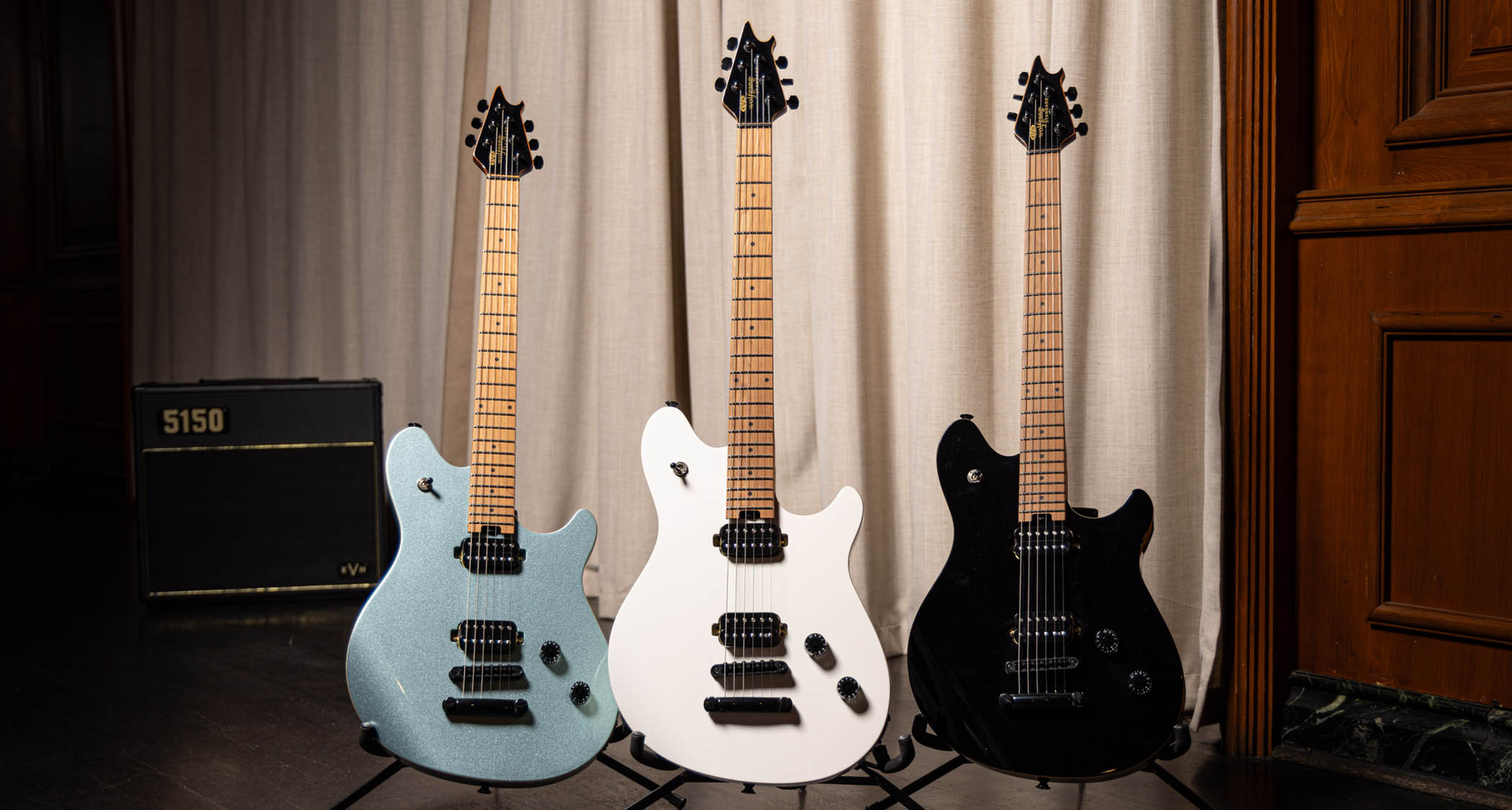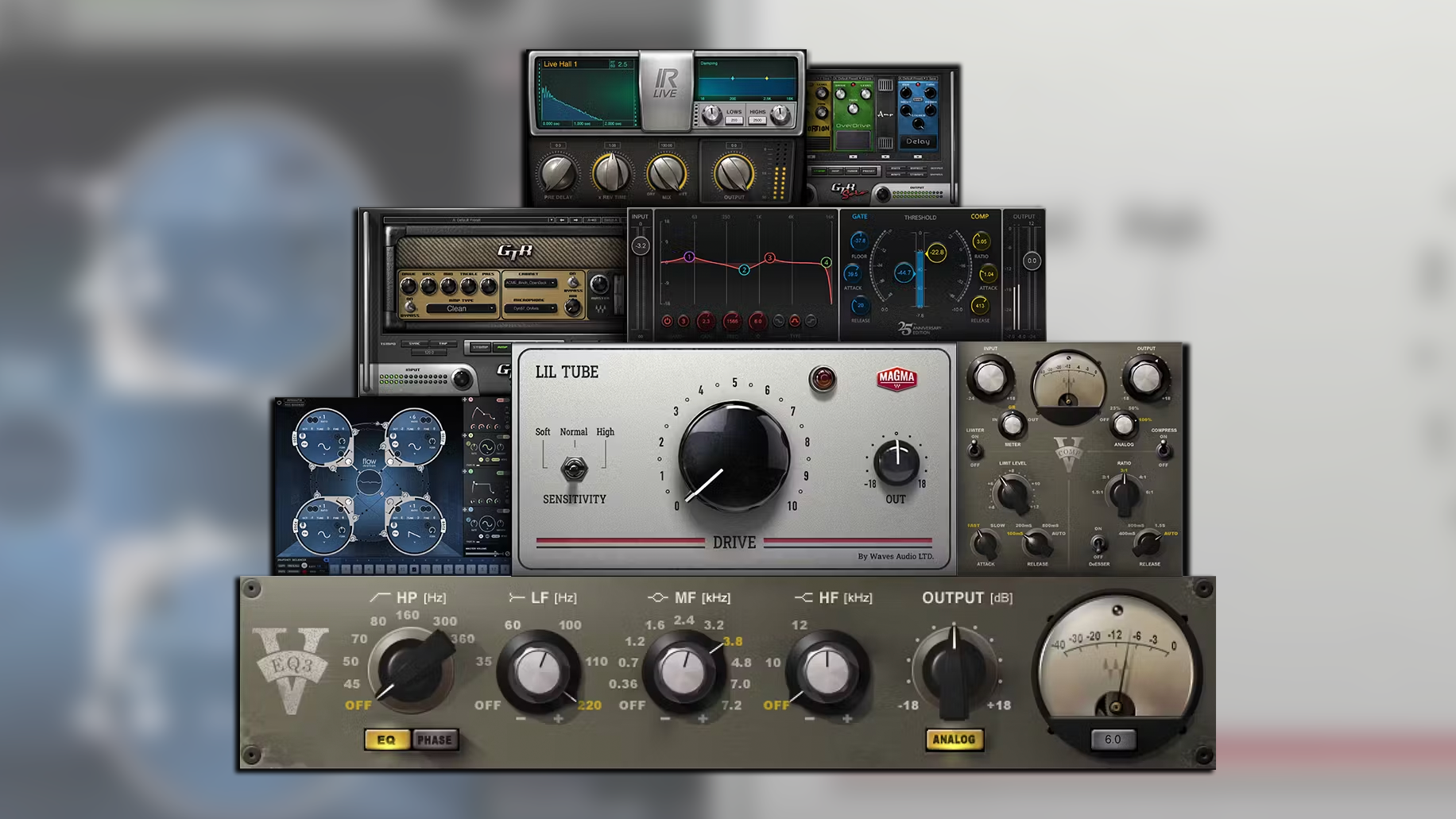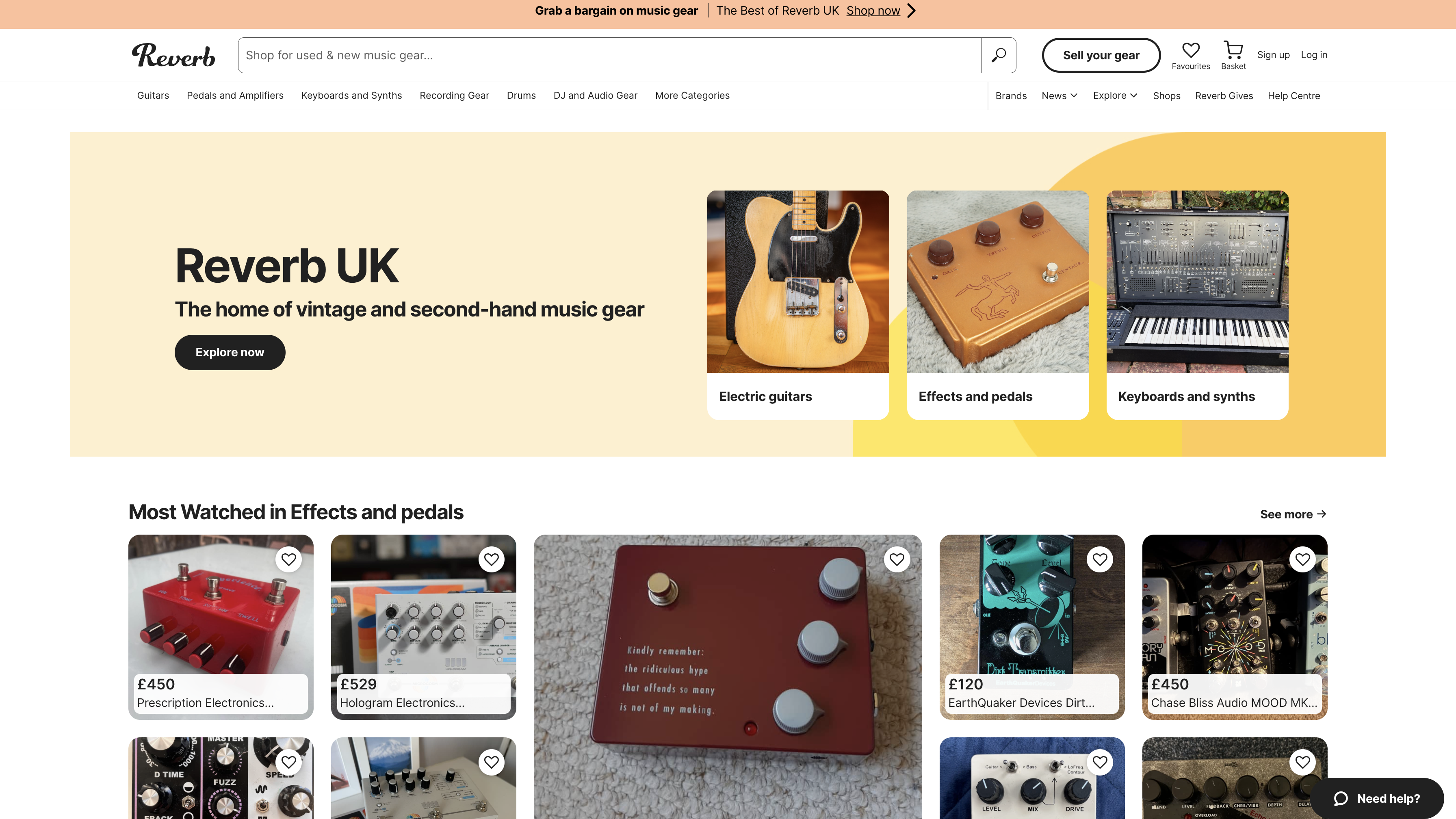12 of the best VST/AU bass synth and instrument plugins
A dozen instruments that are dedicated to your bottom end
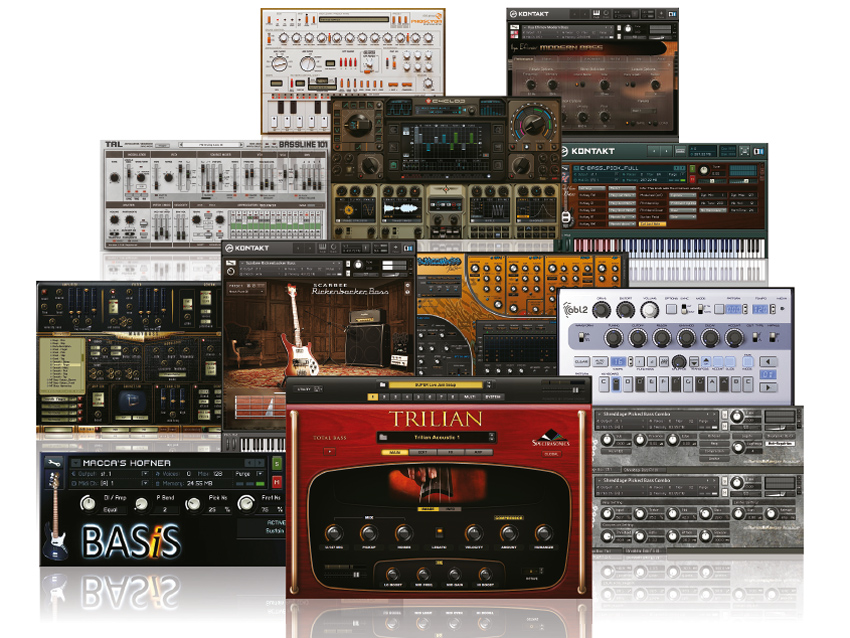
Bass in your face
There’s barely an instrument on the planet that hasn’t been emulated in software by now, so it should come as no great surprise to learn that bass-specific VST and AU plugins are plentiful.
However, there’s more than one way to skin a low-frequency cat and, accordingly, developers have taken different approaches to creating bass instruments, resulting in a surprisingly varied market.
“But why do I need a dedicated bass plugin at all?”, we hear you ask. “I’ve got plenty that ‘do bass’ perfectly well already.” That may indeed be true - there are a lot of excellent ‘all-rounder’ synths out there that are ideally suited to producing bludgeoning bass tones - but sometimes it’s useful to be able to call on a dedicated tool for the job. Not only can this deliver a slightly different kind of sound, but it might also offer some bass-specific features that will give you a more enjoyable editing and mixing experience.
"There are a lot of excellent ‘all-rounder’ synths out there that are ideally suited to producing bludgeoning bass tones - but sometimes it’s useful to be able to call on a dedicated tool for the job."
And then there are electric and acoustic basses - ‘real instruments’, in other words. Again, you might very well already own a sampler with patches that cover these, but a focused bass instrument has the potential to offer a greater level of realism. For example, most offer a variety of performance articulations that make it possible for you to create basslines that sound like they’ve been played by an actual human being.
In this round-up of bass-orientated software we’re going to be covering instruments that are powered by both synth- and sample-based engines, and there are also products that combine the two to create all-encompassing bass solutions. As a user, the trick, as always, is to work out exactly what kind of sounds and editing features it is that you’re looking for. Once you’ve done that, the good news is that there will almost certainly be a bass package out there that meets your requirements.
NEXT: Rob Papen SubBoomBass
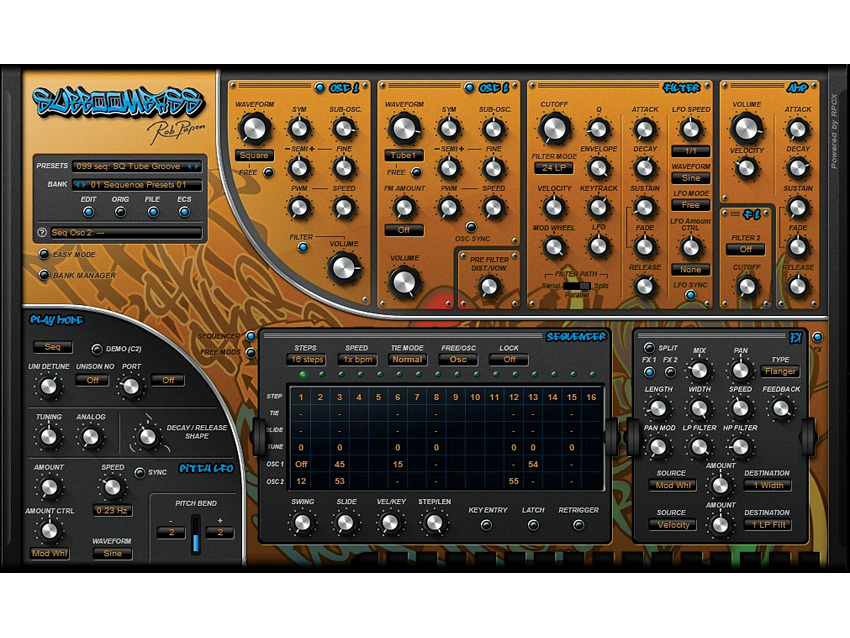
Rob Papen SubBoomBass
Rob Papen has put his name to plenty of great synths - the sadly discontinued Albino 3, a co-production with LinPlug, was a particular favourite among electronic music producers - but while many of them are designed to be quite versatile, SubBoomBass, as its name suggests, is aimed very much at the low end.
In terms of design, there are actually some similarities between SubBoomBass and Predator, another Papen production. The two oscillators share 16 of the same analogue-modelled waveforms, but here you also get 39 additional waveforms that are derived from pitched-down samples of various instruments.
Other features include a distortion stage, two filters of differing specifications and an amplifier section. Also onboard are a step sequencer and Free Modulation section (only one of these can be on display at any given time), plus an effects unit. If all of that sounds too intense, you can engage the Easy Edit mode, which reduces the number of controls and is useful for fast tweaking.
The presets on offer are of predictably high quality (Rob Papen made his name as a sound designer, after all) and, with their depth and power, could easily be put to use in not only the hip-hop and RnB genres that the developer cites, but also many electronic dance music styles.
It might not quite be the only bass synth you’ll ever need, but if you’ve got SubBoomBass in your locker, you’ve certainly got a head start.
Read Rob Papen SubBoomBass review
NEXT: Sugar Bytes Cyclop
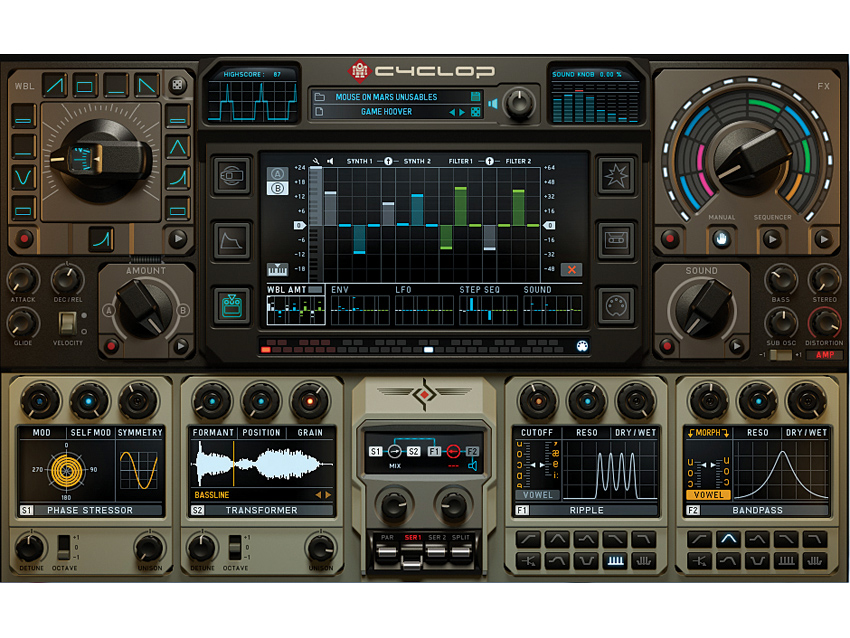
Sugar Bytes Cyclop
In Greek mythology, the Cyclops was a giant with one eye in the middle of his forehead. Cyclop, on the other hand, is a monophonic bass synth - “a powerful monster that has grown out of all the sounds in the universe”. Go figure.
In keeping with the otherworldly aesthetic, Cyclop’s interface looks like it could have come from the command deck of an intergalactic space cruiser, and if you’re used to standard virtual analogue instruments, it might initially be rather confusing. However, Cyclop is actually quite easy to use.
Yes, it’s a synth (with three main oscillators and a sub-oscillator that resides in the master effects section), but its design encourages you to get busy with its modulation system. The key to this is the Wobble section, which enables you to choose from a selection of LFO settings and adjust their speed and shape in real time. There’s also a gate sequencer, a 16-step modulation sequencer and an automation recorder.
This being a Sugar Bytes plugin, you’d expect some funky effects, too, and Cyclop doesn’t disappoint on that front. There are eight programmable slots, each of which can host up to four effects - one each from the Pitch-Looper, Looper, Vinyl FX and Send FX ‘types’.
Although Cyclop does offer some deeper editing controls, most users will be able to get by just tweaking the main knobs, and therein lies a lot of its appeal. It’s best suited to creating fat, defiantly digital-sounding bass patches and evolving tones (some 800 presets are included), and definitely has a contemporary feel to it. Cyclop’s sounds are undeniably big, and capable of leaving a distinctive mark on your productions.
Read Sugar Bytes Cyclop review
NEXT: D16 Phoscyon
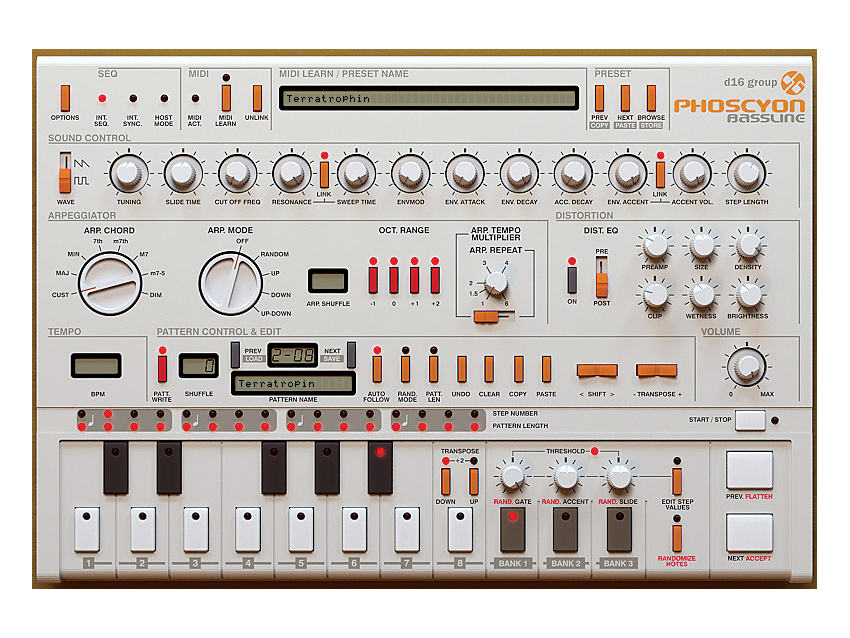
D16 Phoscyon
Thanks to Roland’s recent hardware revival of its classic TB-303 Bass Line synth - the Aira TB3 - the profile of this squelchy, acid house-friendly instrument is higher than it has been for some time. But software developers have been releasing 303 emulations for years now (Propellerhead Software kickstarted the trend with the launch of the seminal ReBirth back in 1998), and Phoscyon is certainly one of the better ones.
Its core synthesis engine stays true to the original, with a choice of saw and square waves and an 18dB/ octave low-pass filter. 303 diehards may complain that Phoscyon doesn’t sound totally authentic, but it should be convincing enough for most people.
What’s more, you have greater tweaking potential thanks to the inclusion of additional parameter controls, and the ‘303 with bells on’ philosophy extends to the all-important sequencer section, which offers more options than the original hardware.
This isn’t the only onboard pattern-generating tool, either: there’s also a decent arpeggiator that lets you choose from seven predefined chords and four patterns, a randomiser that creates patterns from a user-defined range of notes, and an editable distortion module that sounds as gritty as you’d hope.
Despite these additions, Phoscyon still isn’t the most flexible bass synth in the world - its sonic range is definitely limited - but if you want that classic 303 sound in a slick and tweakable package, it’s an excellent option.
NEXT: Togu Audio Line TAL-BassLine-101
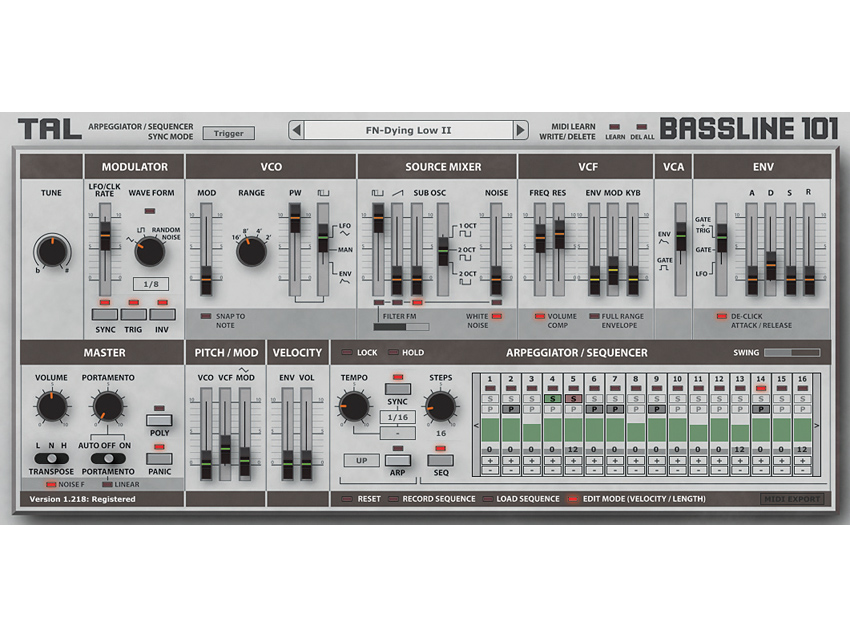
Togu Audio Line TAL-BassLine-101
Although it’s not quite as famous as the TB-303, Roland’s SH-101 synthesizer, released in 1983, is also considered a classic. And once again, it excels at producing punchy bass tones - which brings us nicely to TALBassLine-101.
Unashamedly inspired by Roland’s hardware (though also completely unofficial), Togu Audio Line’s offering has the look, feel and - most importantly - sound of the original. All that’s missing is the handgrip that enabled you to turn the 101 into a keytar.
So, with TALBassLine-101 you get a clear, approachable interface festooned with sliders enabling you to control the levels of simultaneous saw, pulse, noise and sub-oscillator waves. The filter is a self-oscillating 24dB resonant lowpass affair, and there’s also an ADSR envelope, an LFO with square, random and noise wave shapes, and various other controls.
The original SH-101 was monophonic, and though TAL’s version can operate in this mode, there’s a polyphonic option, too. Other features have been added to bring the synth into the DAW age, and the sequencer/arpeggiator section is much easier to use than it ever was on the hardware.
What’s very familiar, though, is the sound, which is eerily similar to that of the original. Some 300 presets come supplied, and TALBassLine- 101 is perfect for producing tight and controlled synth basslines.
That said, the same could be said of many other synths, so it’s real 101 aficionados who’ll most appreciate this emulation. Others may choose to test the waters with the free (but now unsupported) TALBassLine, which might not be quite as authentic, but certainly has that SH vibe.
Read Togu Audio Line TAL-BassLine-101 review
NEXT: Spectrasonics Trilian
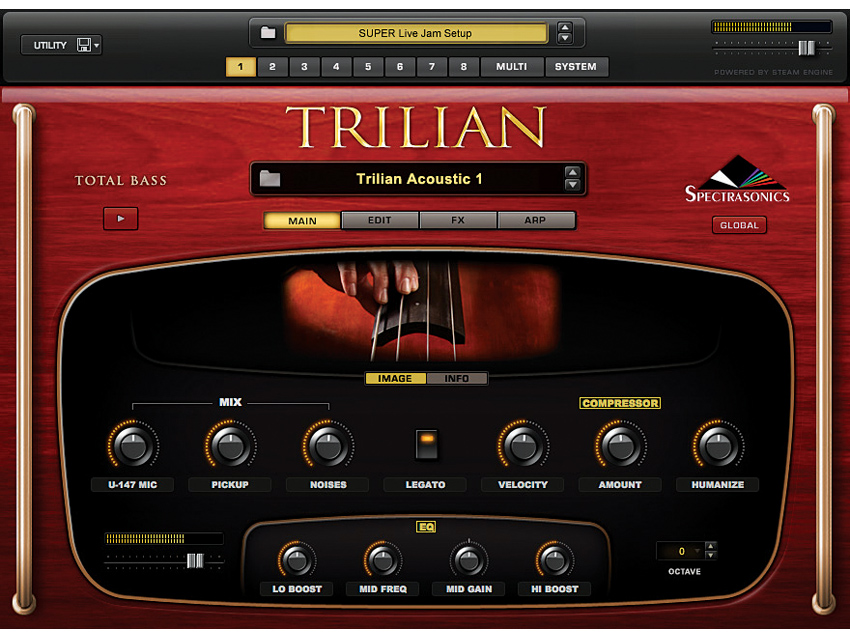
Spectrasonics Trilian
Trilian is sold as a ‘Total Bass Module’, and as soon as you start to look at what it offers, you realise that its developers weren’t messing about when they created it.
It aims, quite literally, to cover all basses, putting acoustic, electric and synth patches under one roof. It’s backed up by a mighty 34GB sample library, which equates to sounds of incredible detail and quality.
Patches are built from one or two layers, each of which can be tweaked using a selection of synth-style controls. You can layer up to eight patches into a multi, each one with its own level, pan, MIDI channel and auxiliary effect settings.
Although it’s possible to go pretty deep with your editing (tabs in the interface take you to various screens), you could easily get by just using the controls on the main screen, the specifics of which change according to the currently selected sound.
And what sounds they are: not only are the acoustic and electric basses stunningly authentic, but they also come with some fantastic articulations, which are so good that it almost feels like you’re playing the real thing. The synthetic patches are equally impressive, taking their inspiration (and samples) from a wide range of classic instruments.
Both for playability and results, then, Trilian is a winner. The only possible downside is that it might do too much: if your requirements are very specific, there’s probably not much point in paying for an instrument this comprehensive.
Read Spectrasonics Trilian review
NEXT: Chris Hein Bass
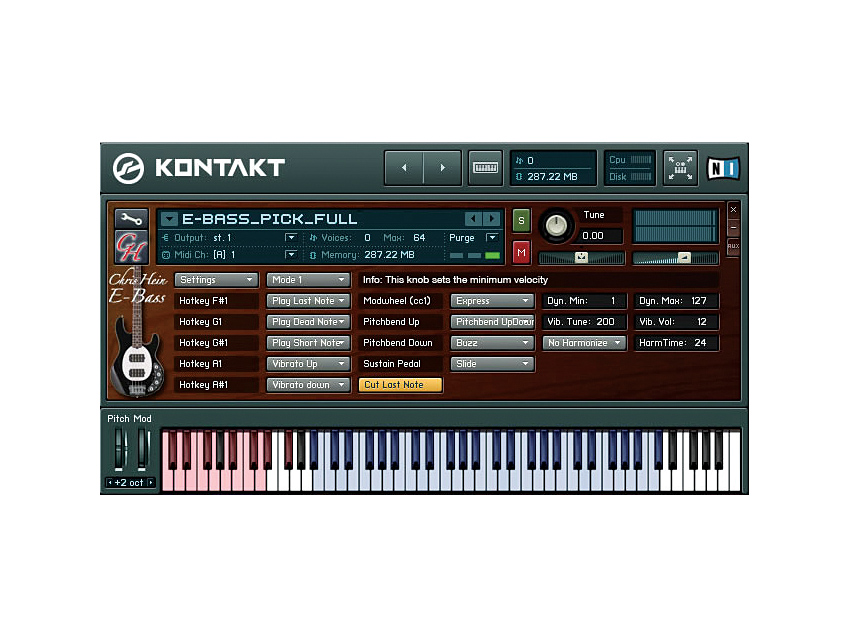
Chris Hein Bass
Chris Hein might sound like the name of a guy you vaguely remember sitting next to in geography at school, but he’s actually a specialist at sampling real instruments and turning them into software ones that you can play in your DAW. He’s used his microphones to capture the sounds of everything from a French horn to a chromatic harmonica, and - as you may have guessed by now - he’s also sampled a variety of bass instruments in forensic detail.
The results of his work are included in Chris Hein Bass, which offers a Music Man StingRay in picked and slapped guises, a LeFay fretless bass, and a “unique” upright bass that you can choose to have played with steel, nylon or gut strings.
You get a total of 12.7GB of sample content (some of the instrument patches were constructed using over 4000 samples and eight velocity layers), and the 42 included articulations make it possible to create basslines that not only have a sound that’s ‘real’, but also give the impression that they were performed, rather than programmed, by human hands. There’s even a mode that enables you to play chords, and eight built-in effects, too.
On the downside, while there are plenty of editing options, the Kontakt Player 2 engine that Chris Hein Bass uses is unfortunately rather dated (though the library can be loaded into later versions of it, too). And then there’s the price - these basses certainly sound fantastic, but they represent a pretty serious investment, particularly when you consider that, unlike with Trilian, for example, you’re not getting any synthetic sounds thrown in to sweeten the deal.
NEXT: Scarbee Basses
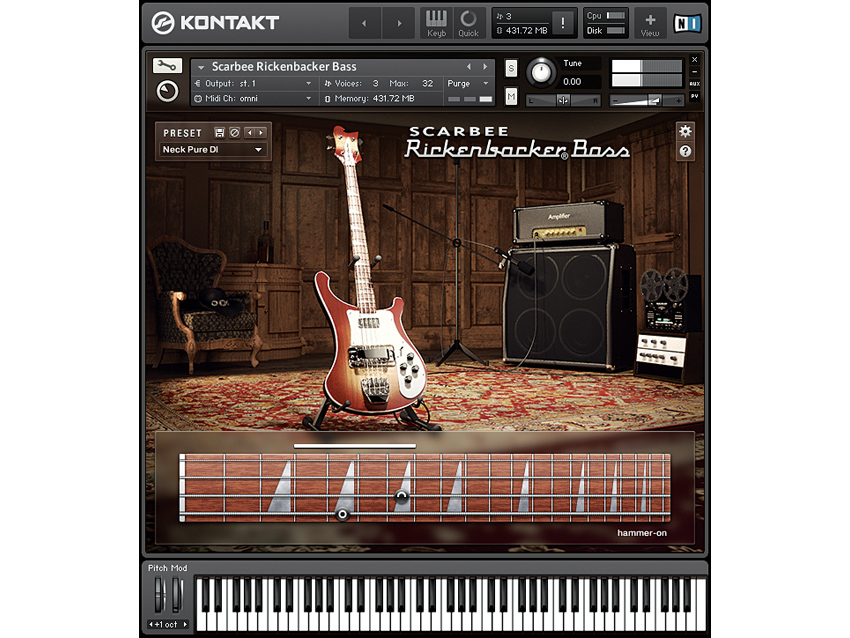
Scarbee Basses
Scarbee is the company name of great Dane Thomas Skarbye, another man who spends an inordinate amount of time sampling the sounds of real instruments.
He appears to have a particular fondness for electric bass guitars, with his range including a total of six different products. They were all created in collaboration with Native Instruments, and will run in both the full version of Kontakt and the free Kontakt 5 Player.
First, there’s the Rickenbacker Bass; this is an officially endorsed emulation of the Rickenbacker 4003, which has been the driving force behind all manner of rock and pop hits. The MMBass, meanwhile, was inspired by the smooth-fingered sound of Chic’s Bernard Edwards, and is great for disco and funk applications.
The versatile Pre- Bass, meanwhile, gives you the sound of Fender’s Precision Bass, while the Jay-Bass is particularly adept at producing slapped and fingered tones. The line-up is completed by Amped versions of the MM- and Pre-Bass, each of which adds four amp sounds.
You can’t really go wrong with any of these instruments: each one provides a stunningly authentic representation of the instrument that it emulates, and comes with articulations that help you to create even more realistic performances. You may find the number of options available a bit bewildering, but if you’re looking for close attention to detail, you’ll find it here in spades.
Find out more about Scarbee Basses
NEXT: Manytone ManyBass
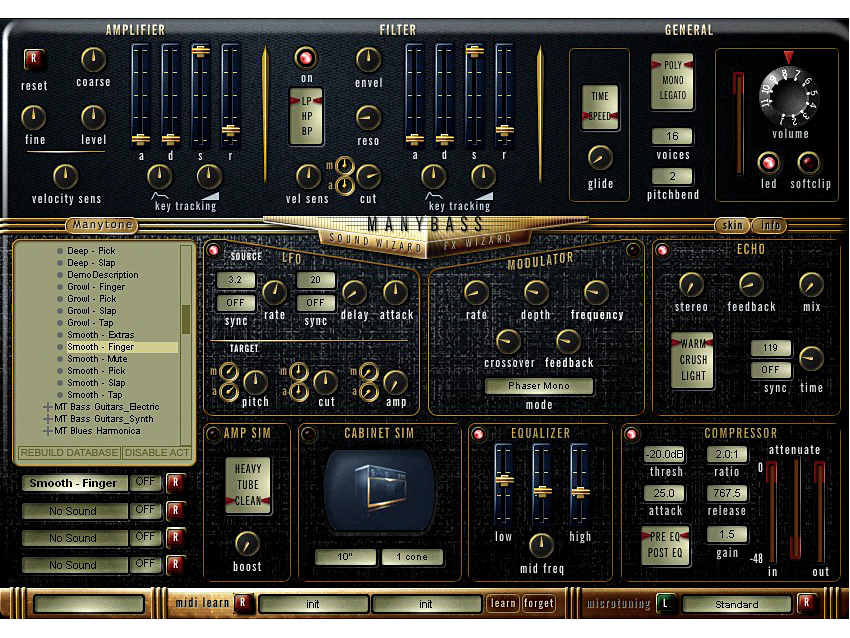
Manytone ManyBass
Although it might at first glance look like an instrument that’s designed for creating cutting-edge electronic sounds, ManyBass’s focus is very much on the bass guitar.
It comes with a 2.4GB library of multisamples of said instrument, and plonks them into a playback engine that’s fronted by an intuitive interface sporting an array of synth-style controls. The sounds are divided into three categories based on their pickup settings: Deep, Growl and Smooth. You can choose from different playing techniques, too (fingered, slapped, picked and so on), and it’s possible to load up to four articulations of an instrument and switch between them.
The overall quality of the library is excellent. Many of the sounds are familiar, seemingly designed to replicate the tones that you’ve heard used on famous recordings, and most will sit well in a mix right out of the gate.
The result is an instrument that can sound very convincing; you also get a selection of raw waveforms that can be used as the basis for synthetic bass sounds. There are built-in amplifier and cabinet emulations, as well, plus an effects rack that covers phasers, chorus, flangers, echo and compression. A selection of add-on packs is available, so you can add more instruments (including an upright bass) should you decide that you need them.
All in all, then, there’s a lot to like about ManyBass. The core sample library is good, and it powers patches that are both playable and, thanks to the software’s design, easy to tweak. The price tag might be a little rich for producers on a budget, but take the demo version for a spin and ManyBass may well win you over.
NEXT: AudioRealism ABL 2
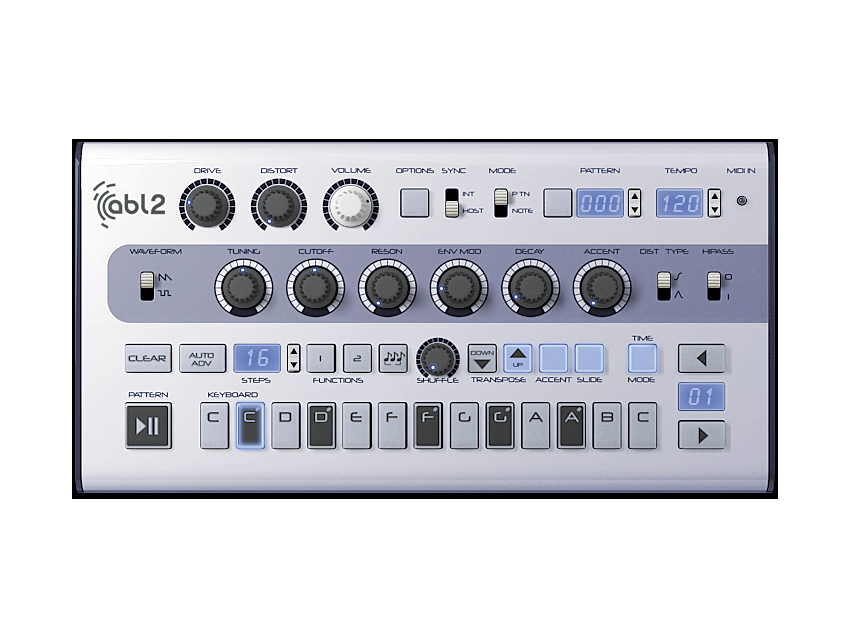
AudioRealism ABL 2
As you’ll have gathered from this round-up, software emulations of Roland’s TB-303 aren’t exactly thin on the ground. But even in such a crowded field, AudioRealism’s effort has always stood out.
The premise behind ABL (that stands for AudioRealism Bass Line, in case you hadn’t worked it out) has always been simple: take the sound and spirit of the original 303, then spice it up with some extras and present it in a DAW-friendly format.
ABL’s sounds are generated using analogue modelling (and juicily convincing they are too), and the obligatory step sequencer is in place; this comes with not only Accent and Slide functions but also per-pattern shuffle. There’s a high-pass filter, while a distortion unit dishes the dirt.
These and various other functions are presented on ABL 2’s concise front panel, but step behind this and you’ll ind a configuration screen which enables you to tweak the sonic and operational characteristics of the instrument, and a pattern analyser tool for detailed editing. The latter even enables you to create new patterns out of analysed audio files - ReBirth pattern import is an option as well.
As it stands, ABL is a cracking virtual 303, but it might be about to get even better with the launch of version 3, which is scheduled for release soon. This promises a completely new analogue emulation model and a ‘pure 303’ sound, so if you’re a real TB junkie, it might be worth holding out for.
Find out more about AudioRealism ABL 2
NEXT: Vir2 BASiS
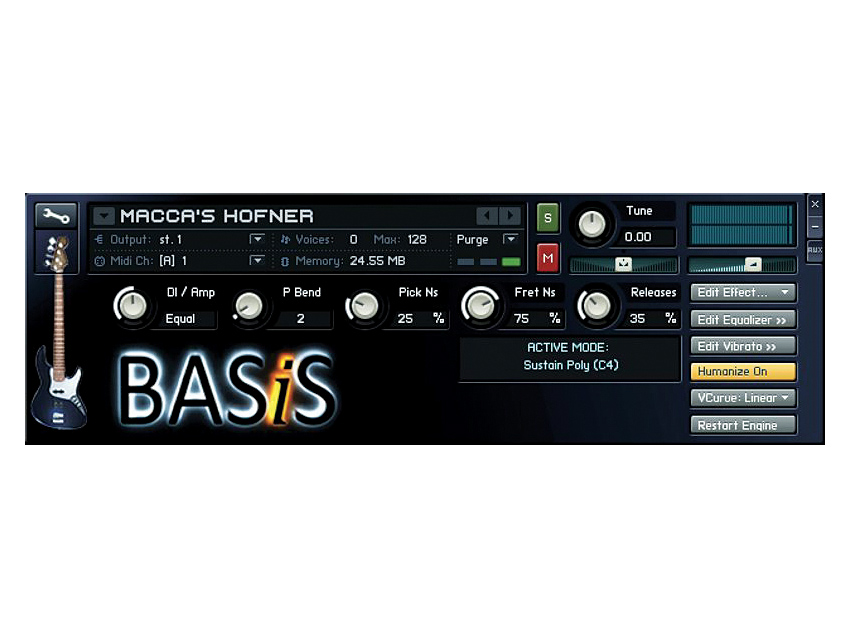
Vir2 BASiS
BASiS is another one-stop bass solution, offering a wide range of sample-based patches that deliver electric, acoustic and synth sounds.
The list of included bass guitars reads like a who’s who of the history of the instrument - classic Fender, Rickenbacker and Music Man models are all here, and there are fretless offerings, too. You’ll also find dedicated upright and slap basses, and in excess of 100 of the aforementioned synth patches.
All of this ground is covered by a 7GB library that runs in the ageing Kontakt Player 2 engine (BASiS is getting on a little now), but there are still plenty of ways for you to tweak your tone and hone your playing technique with it. With the electric basses, you can mix phase-aligned DI and amped inputs, for example, and various keyswitch modes aid performance (there’s a legato mode and various different vibrato styles, for example). You can also adjust the amount of pick, fret and release noise.
The software’s completist nature is emphasised by the fact that you also get a decent effects section and tweakable EQ.
It’s fair to say that the synth sounds in BASiS aren’t its strongest element - some are quite usable, but you’ll probably pass on most of them. On the whole, however, the results you can get out of this instrument are pretty darn impressive. It doesn’t quite pack the punch that Trilian does, but if 34GB of low-end sounds seems like overkill, BASiS provides a less weighty alternative.
Find out more about Vir2 BASiS
NEXT: Impact Soundworks Shreddage Bass: Picked Edition
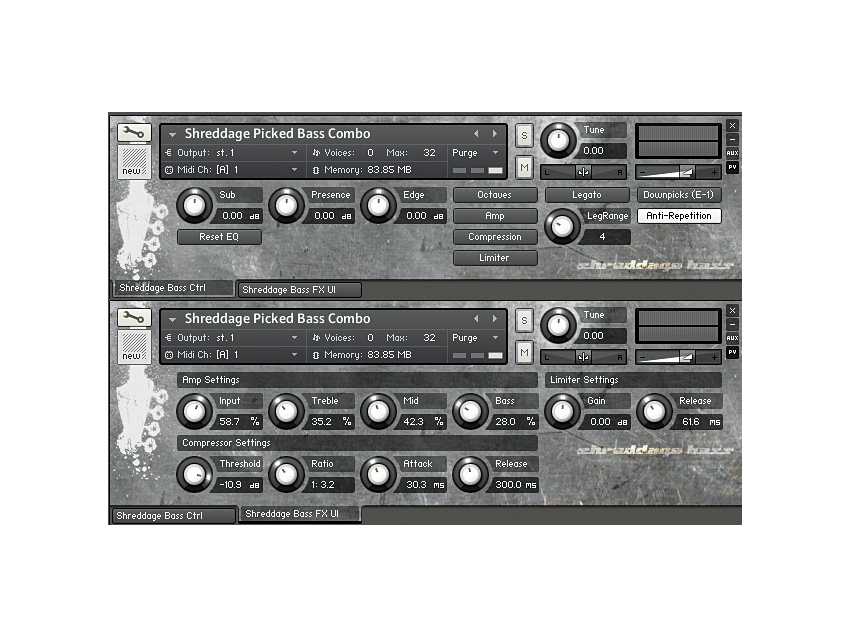
Impact Soundworks Shreddage Bass: Picked Edition
Impact Soundworks is probably best known for its Shreddage guitar products, which enable you to create thunderous axe parts within your DAW. Shreddage Bass: Picked Edition is cut from similar cloth, but while both its name and packaging might lead you to suspect that it’s designed exclusively for metal fans, this is actually a more versatile instrument than it first appears.
We say instrument, but what we’re dealing with here is a sample library that’s designed to load in the full version of Kontakt (users of the free Kontakt Player need not apply, sadly) or an SFZ-compatible sampler (Impact Soundworks recommend Plogue’s Sforzando). It features just one bass guitar - a DI’d Music Man Sterling. This leaves you with a very clean sound; Impact Soundworks’ argument is that this provides the greatest tone-crafting flexibility, with the library responding well to any kind of processing you like. That said, the instrument is designed to sit well in the mix with minimal tweaking.
As is customary, a number of suitable articulations, round robins and velocity layers are included; you can play open, muted and staccato notes with relative ease. Neck slides, hammer-ons and pull-offs are also possible.
Predictably, Shreddage Bass sounds great with rock and metal styles, but it’s also a decent library for anyone who just wants a great-sounding picked bass guitar at a very reasonable price.
Find out more about Impact Soundworks Shreddage Bass: Picked Edition
NEXT: Ilya Efimov Bass Bundle
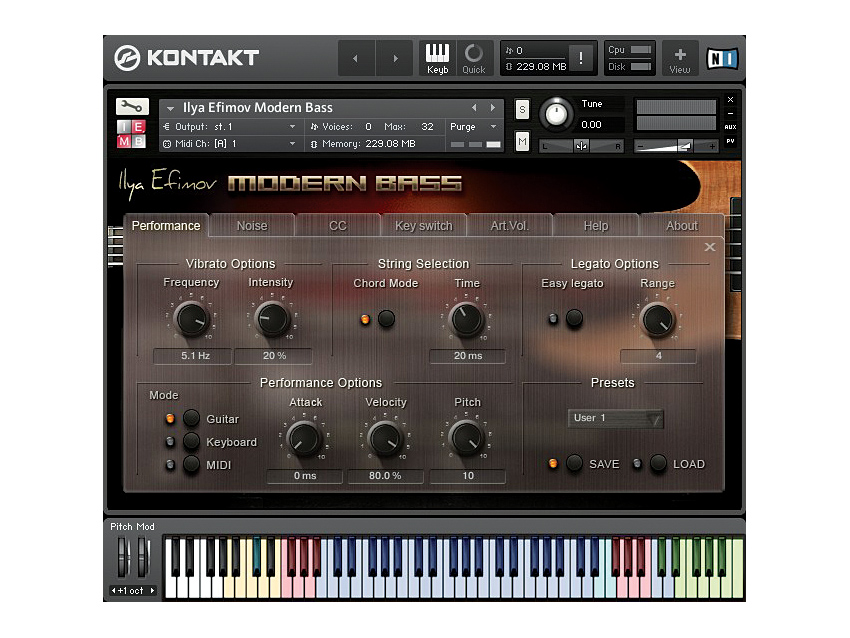
Ilya Efimov Bass Bundle
Ilya Efimov is a film and television composer, jazz pianist, songwriter and producer, and thankfully for computer musicians, he’s also made some cracking sample libraries. How’s that for a Renaissance man?
Efimov’s Bass Bundle brings together four low-end beauties. Each of these is also available separately, but you’ll save a significant amount of money if you buy them together.
To give you an overview of the package, Modern Bass replicates a 5-string “studio custom” guitar from FBass, Classic Bass is a virtual Fender Precision, Retro Bass is an emulation of another Fender model dating from 1952, and Fretless Bass is a second FBass-derived offering. In each case, the instruments have been sampled at multiple velocity levels (up to 12, in fact), a round-robin algorithm is provided for extra realism, and a number of suitable articulations are available.
Amp sims are also part of the deal, as are effects and the option to dial in the likes of fret and release noises.
With user-friendly interfaces and the grunt of NI’s Kontakt engine behind them, these are slick libraries, and in the right hands they can be made to generate bass parts that sound almost indistinguishable from those played by capable real-life performers.
The fly in the ointment, however, is compatibility. Unfortunately, only users of the full version of Kontakt 4 or 5 can avail themselves of these samples; if you’re not an owner of said software and don’t see enough reason to invest in it, you can always fall into the welcoming arms of Scarbee’s basses, which do provide Kontakt Player compatibility.
![Gretsch Limited Edition Paisley Penguin [left] and Honey Dipper Resonator: the Penguin dresses the famous singlecut in gold sparkle with a Paisley Pattern graphic, while the 99 per cent aluminium Honey Dipper makes a welcome return to the lineup.](https://cdn.mos.cms.futurecdn.net/BgZycMYFMAgTErT4DdsgbG.jpg)
